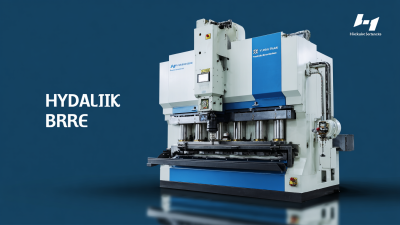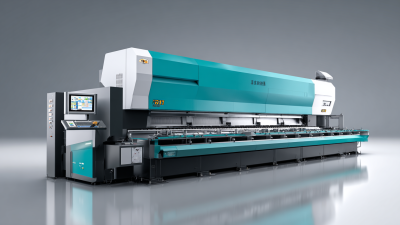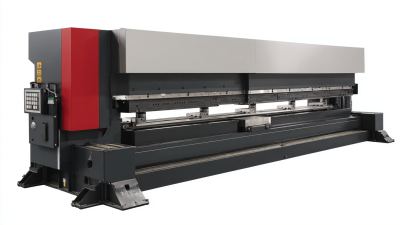Why Understanding Hydraulic Press Brakes is Essential for Modern Manufacturing
In today's competitive manufacturing landscape, understanding the intricacies of hydraulic press brakes has become indispensable. As per the latest industry reports, the global market for press brakes is projected to reach USD 4.03 billion by 2025, reflecting a CAGR of 5.6% from 2020 to 2025. Hydraulic press brakes play a crucial role in enhancing precision and efficiency in metal bending processes, ensuring that manufacturers can meet stringent quality standards while optimizing production costs. The advanced technology incorporated in modern hydraulic press brakes not only improves operational safety but also integrates seamlessly with smart manufacturing systems, facilitating real-time monitoring and higher automation levels. As industries continue to evolve, leveraging the full potential of hydraulic press brakes will be essential for manufacturers aiming to stay relevant and competitive in the fast-paced market.

Understanding the Basic Mechanics of Hydraulic Press Brakes
Understanding hydraulic press brakes is crucial for modern manufacturing, as these machines leverage the principles of fluid mechanics to enhance efficiency and precision in metal forming. At the core of hydraulic press brakes is Pascal's Law, which states that pressure applied to a confined liquid is transmitted undiminished in all directions. This fundamental principle allows hydraulic systems to exert immense force precise enough for intricate bending tasks. The mechanics involved—including the fluid-driven actuation of the brake—enable operators to achieve consistent results, significantly contributing to improved productivity on the shop floor.
Furthermore, modern press brakes have been equipped with advanced features that optimize their operation, ensuring that users can maximize their bending time rather than wrestling with setup processes. With the emergence of smart technologies, these machines offer not only increased safety but also enhanced functionality, all while adhering to strict regulatory standards. As manufacturers increasingly demand faster and more effective solutions, understanding the mechanics of hydraulic press brakes becomes indispensable, allowing operators to navigate challenges while maintaining high-quality output.
Key Advantages of Hydraulic Press Brakes in Manufacturing Processes
Hydraulic press brakes are pivotal in modern manufacturing due to their inherent advantages in precision and efficiency. One of the primary benefits of hydraulic press brakes is their ability to handle a wide range of materials and thicknesses with consistent accuracy. This adaptability makes them ideal for various applications, from metal forming to intricate bending tasks, ensuring that manufacturers can meet diverse production needs without compromising on quality.
Furthermore, hydraulic press brakes are designed to operate with minimal force fluctuations, providing a more stable and controlled bending process. This leads to improved repeatability and reduced material waste, as the risk of errors during production is significantly minimized. In addition, these brakes often come equipped with advanced technology such as CNC controls, enabling manufacturers to optimize their operations and streamline processes. As a result, investing in hydraulic press brakes not only enhances productivity but also helps businesses stay competitive in the fast-paced manufacturing landscape.
Selecting the Right Hydraulic Press Brake for Your Operations
Selecting the right hydraulic press brake for your operations can significantly impact efficiency and productivity in modern manufacturing. With various options available, understanding the specific requirements of your production process is crucial. Key factors to consider include the materials being processed, the required bending capacity, and the precision needed for your applications. Investing time in assessing these factors can lead to better decision-making and optimal performance of your machinery.
Moreover, evaluating the available features and technological advancements can help you find the best fit for your operations. For instance, considering automation capabilities, control systems, and energy efficiency can enhance operational workflows and reduce long-term costs. By prioritizing these elements when selecting a hydraulic press brake, businesses can not only improve their manufacturing accuracy but also adapt to the evolving demands of the market, ensuring sustained growth and competitiveness.
Why Understanding Hydraulic Press Brakes is Essential for Modern Manufacturing - Selecting the Right Hydraulic Press Brake for Your Operations
| Feature | Description | Importance |
|---|---|---|
| Pressure Rating | Indicates the maximum pressure the machine can produce. | Critical for ensuring the machine meets production needs. |
| Bending Length | The maximum length of material that can be bent. | Essential for accommodating various material sizes. |
| Back Gauge System | A device that helps in accurately positioning the workpiece before bending. | Increases precision and reduces waste. |
| Control Type | Refers to manual, NC, or CNC controls. | Determines ease of use and automation level. |
| Footprint | The total space required to operate the machine. | Important for planning shop floor layout. |
Maintenance Tips for Optimizing Hydraulic Press Brake Performance
Maintaining hydraulic press brakes is crucial for ensuring optimal performance and longevity in modern manufacturing. Regular maintenance practices, such as inspecting hydraulic fluid levels and checking for leaks, play a significant role in preventing potential breakdowns. It's essential to clean the machine's components regularly to eliminate dirt and debris that could impede its function. Operators should also monitor the alignment and calibration of the press brake to achieve precise bends and cuts, which are vital for quality control.
Additionally, replacing worn-out parts promptly can prevent more extensive damage and costly repairs. Regularly reviewing the manufacturer's guidelines for lubrication and part replacement schedules will help maintain the hydraulic system's efficiency. It's beneficial to keep a log of maintenance activities, as this can help identify patterns or recurring issues, leading to proactive solutions. By prioritizing routine maintenance, manufacturers can enhance the productivity and safety of their hydraulic press brakes while extending their operational lifespan.

Innovative Applications of Hydraulic Press Brakes in Modern Industry
 Hydraulic press brakes have transformed modern manufacturing with their innovative applications across various industries, particularly in automotive and aerospace sectors. The Press Brake Machine Market is projected to significantly grow, with technological innovations driving efficiency and precision. Reports indicate that advancements in hydraulic systems can increase bending accuracy by up to 30%, which is crucial for creating complex components used in modern vehicles.
Hydraulic press brakes have transformed modern manufacturing with their innovative applications across various industries, particularly in automotive and aerospace sectors. The Press Brake Machine Market is projected to significantly grow, with technological innovations driving efficiency and precision. Reports indicate that advancements in hydraulic systems can increase bending accuracy by up to 30%, which is crucial for creating complex components used in modern vehicles.
One notable application of hydraulic press brakes is in the production of automotive brake systems. As outlined in market analysis, the automotive brake systems market size is expected to experience a robust increase, fueled by the rising demand for more efficient and reliable braking solutions across all vehicle types, from sedans to SUVs. This trend highlights the importance of integrating advanced hydraulic technologies to improve manufacturing processes.
Tips: When choosing a hydraulic press brake, consider factors such as tonnage, length, and precision needed for your specific applications. Additionally, staying updated with emerging trends in hydraulic lift technology can provide valuable insights into enhancing your operational capabilities in the evolving manufacturing landscape. Embracing these innovations will not only enhance productivity but also ensure compliance with industry standards.
Related Posts
-

Unlock Precision and Reliability: Partner with China's Finest for Hydraulic Press Brake Solutions
-

Discover the Excellence of China's Leading Factory for the Best Small Press Brake Solutions Worldwide
-

Discover the Advantages of Choosing the Best Press Brake for Your Manufacturing Needs
-

Craftsmanship Redefined Chinese Manufacturing Delivering the Best Press Brake Solutions Worldwide
-

Ultimate Guide to Choosing the Best Hydraulic Press Brake Machine for Your Needs
-

Ultimate Guide to Mastering Metal Press Brake Operations for Precision Fabrication
